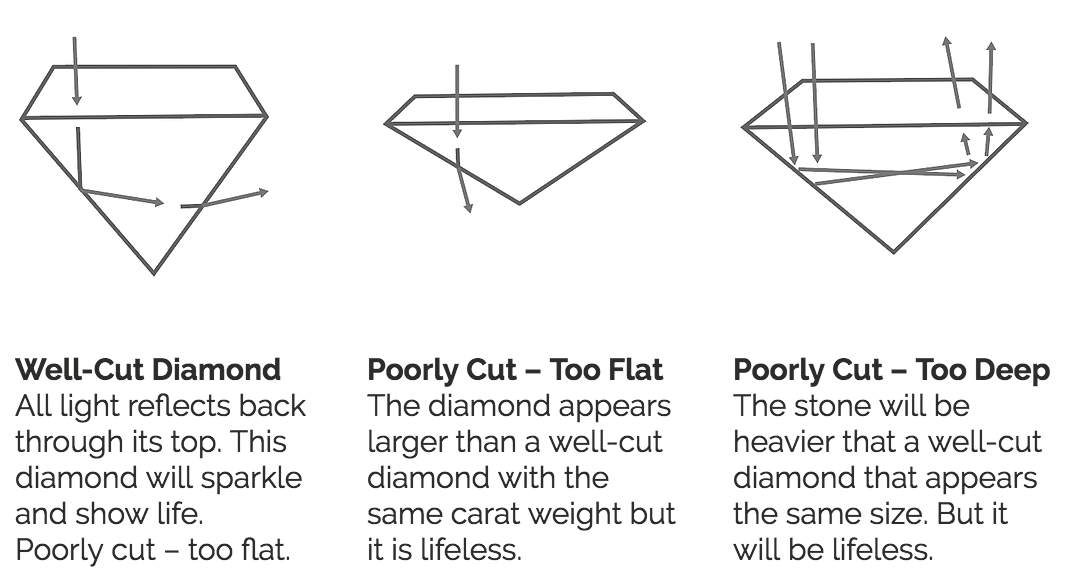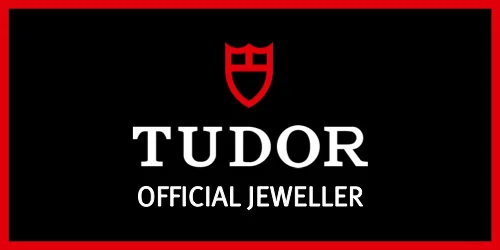Diamond Education Center
1-ON-1 DIAMOND TRAINING AT PROVIDENCE DIAMOND
CUT. IN GRADING, "CUT" EVALUATES THE SKILL IN CUTTING OF THE DIAMOND. CUT IS ARGUABLY THE MOST IMPORTANT ELEMENT BECAUSE IT IS DIRECTLY RESPONSIBLE FOR THE DIAMOND'S SPARKLE AND BRILLIANCE. A well-cut diamond is cut precisely to the proportions that yield the most light return. Here's the reason a diamond sparkles: Light enters through the table (top) and reflects off the cone-shaped pavilion until it comes back through the top, giving the diamond that spectral sparkle. But if a diamond isn't cut well, the light never comes back up; it leaks out the bottom or sides of the diamond. It has little sparkle and life.
Three components comprise "cut." They are: proportions, symmetry, and polish. Do the cuts on the diamond meet the angle guidelines for maximum dispersion of light? Is the diamond symmetrical? Are the diamond’s surfaces smooth? Can you see sanding marks? All three of these elements affect the quality of the cut and the diamond’s value, brilliance, and beauty. A grade is assigned to the Cut.

CLARITY. CLARITY IS THE EVALUATION OF A DIAMOND'S INTERNAL AND EXTERNAL CHARACTERISTICS. THE FEWER INCLUSIONS OR BLEMISHES, THE MORE DESIRABLE THE DIAMOND. (INCLUSIONS ARE INSIDE THE DIAMOND; BLEMISHES ARE ON THE OUTSIDE OF A DIAMOND.) To locate most of these tiny characteristics, a jeweler will use a ten power microscope, then, evaluating the size, location, nature, number, and color of all the inclusions and blemishes, a clarity grade is assigned. This characteristic is more than cosmetic; a heavily included diamond can be susceptible to breakage.
There are six main categories:
Flawless (FL): Extremely rare. No inclusions or blemishes.
Internally Flawless (IF): No inclusions and only minor blemishes.
Very Very Slightly Included (VVS): Very minute inclusions seen under scope.
Very Slightly Included (VS): Minor inclusions seen under the scope.
Slightly Included (SI): Noticeable inclusions seen under the scope and a small percentage visible to the naked eye.
Notice that inclusions are visible to the naked eye only in the I grade. In most cases, there’s no link between clarity and beauty.

COLOR. COLOR FOR WHITE DIAMONDS CAN VARY FROM COLORLESS ("D" GRADE AND EXCEEDINGLY RARE) TO LIGHT YELLOW ("Z"). Most diamonds possess some degree of yellow or brown. Small, nearly undetectable, differences in color can make a substantial difference in a diamond’s cost. Generally, the more colorless the diamond the greater the value. If a diamond is well cut, and this is especially true with the round brilliant cut, the diamond’s refraction and dispersion often will disguise certain degrees of coloration.
A diamond with a color rating near the bottom of the alphabet may benefit from a yellow gold setting instead of a platinum or a white gold setting. Diamonds that possess more color than a "Z" rating may be prized as a Fancy (Yellow or Brown or Red or Blue, etc...)

CARAT. THIS IS THE EASIEST OF THE 4CS TO DETERMINE: THE LOOSE DIAMOND IS WEIGHED ON A CALIBRATED SCALE. (A CARAT EQUALS 1/5 OF A GRAM OR 1/142 OF AN OUNCE.) EACH CARAT IS DIVIDED INTO POINTS; EACH POINT REPRESENTS 1/100TH OF A CARAT. SO, A "HALF CARAT DIAMOND" CONTAINS FIFTY POINTS. As diamonds increase in size, their cost tends to increase geometrically. Thus, a one-carat diamond will cost considerably more than twice as much as a one-half carat diamond of equal quality. But carat weight can be very misleading. For example, a diamond might have far greater brilliance and more value if it were cut away, and it consequently weighed less. Diamonds of equal carat weights can have huge disparities in price.
Some diamond shapes, like the cushion cut, do not really lend themselves to small stones, whereas even a small round brilliant diamond can be very striking. You can decide what diamond size will work best for you and your budget by balancing carat weight against the other characteristics.



